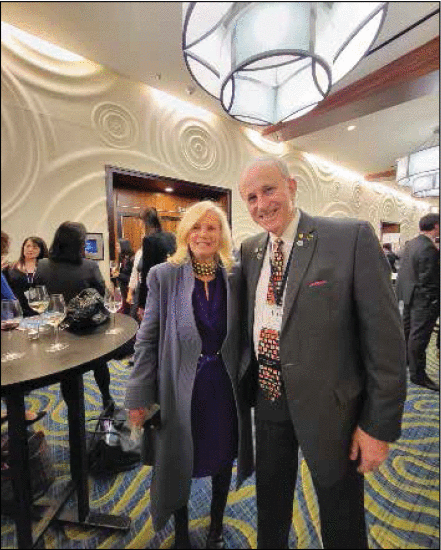 Luis Kun (right) with Dr. Susan Blumenthal, March 2023.
Luis Kun (right) with Dr. Susan Blumenthal, March 2023. For those of us who were lucky as children to enjoy life and grew up with the support of loving families, going to school, playing sports and music, and making friends in our neighborhoods was just a way of life. Little did we know explicitly at the time of the importance of creating and maintaining human connection. As grownups, opportunities occur when we may have information that others lack. Because of social interactions, the use of critical thinking, creativity, and information sharing, we will encounter ways of helping others achieve their objectives. The unexpected ramifications that can occur when this happens are a caress to your soul.
In November 1978, after receiving my doctorate at University of California, Los Angeles (UCLA), I started to work for the IBM Corporation in Los Angeles. Shortly after that I visited the IBM Palo Alto Scientific Center (PASC) and met Ralph Bernstein, at the time manager of the Image Processing Lab at the PASC (Ralph was an IEEE Fellow for discoveries made in that field). I became acquainted with two of his employees, Joe Myers and William Hanson. Years later, I worked with Ralph and Joe in what became the first Teleradiology system under an IBM platform: the medical imaging display system (MIDS). Joe was the single coder of MIDS, a medical imaging display system. William had developed some algorithms that helped analyze images from space sent by the satellites.
In 1988, while working at IBM Dallas, I met Dr. Steven Harms at Baylor School of Medicine. Dr. Harms worked on the early detection of breast cancer in women by analyzing magnetic resonance imaging (MRI) images1 and he had purchased a very powerful new technology “RISC 6000” personal computer (PC) for which there was no software to support his research. I remembered the work I have seen at the PASC and was able to speak with Bernstein and arrange with him a memorandum of understanding describing the broad outlines of an agreement between Baylor and the IBM PASC where a free copy of Hanson’s image-processing software would be provided to support Dr. Harms’ research.
It was a wonderful experience for me to live all of these events and realize later how everything is really connected.
In 1996, while I worked as a senior IT advisor for the Center for Information Technology at the Agency for Health Care Policy and Research (AHCPR),2 my boss Dr. Mike Fitzmaurice asked me if I would like to go to a Health Technology Transfer Conference in Rockville, MD, USA, and I responded positively. At the meeting, I was happily surprised to find a paper written by Dr. Steven Harms describing how he was successful in doing early breast cancer detection in women, using Hanson’s image-processing software algorithms of MRI images with the RISC 6000 system.
After the meeting, I communicated this to my boss and AHCPR. Some weeks or a month later, I received a letter from Dr. Susan J. Blumenthal, who served as U.S. assistant surgeon general and was, at the time, the country’s first-ever deputy assistant secretary for women’s health within the U.S. Department of Health and Human Services.
On Sunday, 26 March 2023, while attending the American Institute of Medical and Biological Engineering (AIMBE) Annual Event, during the Grand Challenge Topic 1: Redesigning Public Health with Technology, Dr. Susan Blumenthal spoke which was followed by a panel discussion. I had the chance afterward to thank her for her congratulatory letter sent to me 27 years before.
Where will the new generations of kids get their “social skills” developed, considering that most of their social relations and interactions happen virtually through their phones or computers while avoiding in-person interactions?
It was a wonderful experience for me to live all of these events and realize later how everything is really connected. This whole lifecycle took 45 years of many exploring, learning, sharing, and connecting events, with many people from different cities, countries, and professions. It also makes me wonder where will the new generations of kids get their “social skills” developed, considering that most of their social relations and interactions happen virtually through their phones or computers while avoiding in-person interactions.
In contrast, below is a picture with Dr. Bijan Najafi, a bioengineer, professor of surgery, and director of clinical research at Baylor College of Medicine, Houston, TX, USA. We also just met the same Sunday, 26 March 2023, at the same AIMBE event, and a “new cycle of life” started.
Author Information
Luis Kun is the 2023–2024 President of the IEEE Society on Social Implications of Technology. He is a distinguished professor emeritus, William J. Perry Center for Hemispheric Defense Studies, National Defense University, Washington, DC 20319 USA. Email: l.kun@ieee.org.
___________
To access the original published version of this article, click HERE.
___________







 JOIN SSIT
JOIN SSIT